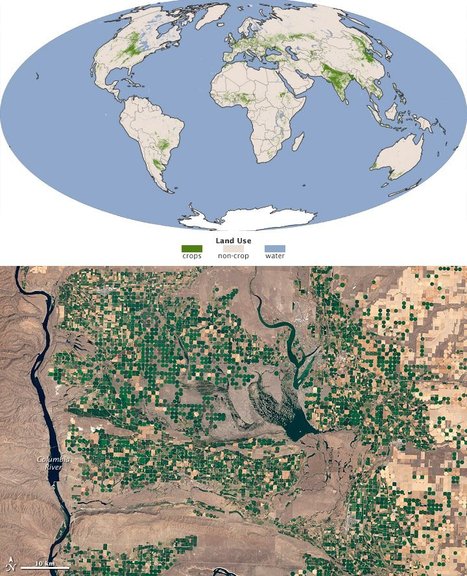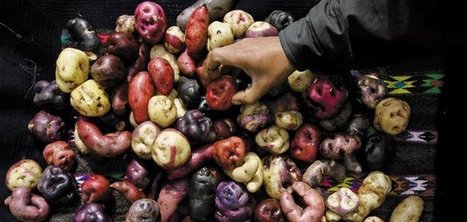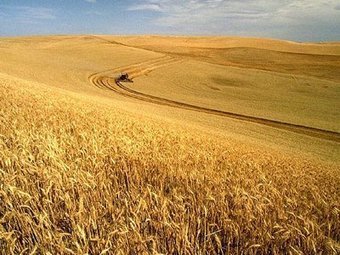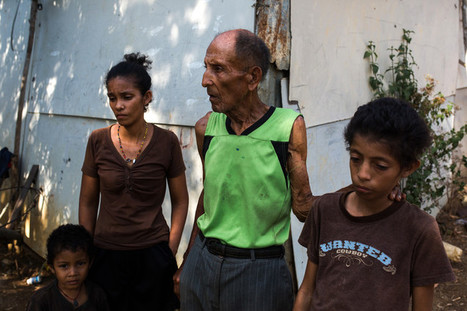This visualization shows Crop Intensity data (regions that produce the most crops), followed by the MODIS croplands product, the 26 countries that produce 82% of the world's food, the population density in 2002 and finally the projected population in 2050.
Get Started for FREE
Sign up with Facebook Sign up with X
I don't have a Facebook or a X account
 Your new post is loading... Your new post is loading...
 Your new post is loading... Your new post is loading...
Matt Manish's curator insight,
February 16, 2018 10:57 PM
The U.S. Census Bureau defines "rural" as an area with less than 50,000 people living in it. The majority of the United States is actually considered rural while a small minority of the country is labeled as urban. But interestingly enough, most rural areas are clustered around urban areas rather than in random locations. It seems as though the further out one ventures out from the center of an urban area like a major city, the more the population begins to decrease. One can also see in the same situation, the area transition from urban to rural. U.S. Census data can tell us a lot about populations in rural and urban areas and the correlation between them which can be important to know for many reasons.
Sabrina Ortiz's curator insight,
March 5, 2017 7:29 PM
My scoop it opinion piece was on global food waste. How globally food is thrown by the tons daily. Its audience is everyone and its purpose is to try to get people to open their eyes and waste less. America makes over four times the amount needed to feed its people. We are hurting the environment by making so much food that just go to waste. The purpose of this is to illustrate the huge issue we have with countries of people who don’t have food to begin with and here we are throwing away perfectly good food that could be use for these people or to feed pigs to make more meat. His exigence is all the food that could be use for other people or animals and its going to land fills daily. Its like a ticking time bomb hurting earth. His constraints are the laws set on food given to live stock in Europe and companies and the corporations that control the food. He urges people to use the amount of food they truly believe they will eat.

Brady Jones's comment,
February 9, 2017 6:55 PM
Measurements from the Landsat satellite also make it possible to tell how much water the crops consume in an arid environment. Such measurements are likely to become more important as demands on limited water resources increase. Currently, agriculture accounts for 85 percent of the world’s fresh water consumption

Brady Jones's comment,
February 9, 2017 6:55 PM
Measurements from the Landsat satellite also make it possible to tell how much water the crops consume in an arid environment. Such measurements are likely to become more important as demands on limited water resources increase. Currently, agriculture accounts for 85 percent of the world’s fresh water consumption

Brieanna Hepburn's comment,
February 13, 2017 6:15 PM
With seven billion people now living on Earth, the ever growing demand is putting unprecedented pressure on global resources—especially forests, water, and food.

Kaitlin Young's curator insight,
December 13, 2014 12:57 PM
Potatoes are one of the most widespread foods in the world, due to its resiliency to harsh weather conditions and its ability to grow to large sizes. Potatoes can also be traced to show the beginning forces of globalization. Before modern communication and transportation technology, globalization occurred at a much slower rate. Globalization spread through trade routes in the forms of foods, resources, and therefore cultures and people.
BrianCaldwell7's curator insight,
March 16, 2016 3:52 PM
The Colombian Exchange is a term that describes the most dramatic biologic transfer in history. European explorers brought animals and agricultural items from the Old World to the New and subsequently brought back items from the New World back to the Old. This exchange profoundly reshaped many societies as agricultural diffusion of the potato lead to the changes across northern Europe.
Tags: agriculture, food production, diffusion, historical, colonialism, Europe. |

Zavier Lineberger's curator insight,
February 9, 2018 10:46 PM
(South America) It's depressing to see the dramatic turn of events in Venezuela's political and economic climate in recent decades, coming from the richest country in Latin America to the country with the world's highest inflation rates and number two on country murder rating. This causes increased levels of crime, stealing and looting food for families to survive. The Venezuelan government has refused foreign aid and yet cannot find a solution to fixing the lack of food, healthcare, and medicine. This problem affects several South American countries and always poses a threat of travelling across borders. We tend to think of the Western World as more enlightened yet just south of the US we find authoritarian countries with the highest crime rates in the world, starving its own people.
Katie Kershaw's curator insight,
February 15, 2018 2:05 PM
Sometimes the world seems like a really hopeless place and this article definetly supports that train of thought. Venezuela only a few years ago produced enough food to feed themselves and actually had enough surplus that they were able to export. What they couldn’t grow they would import. The food shortage that the country is facing is not an agriculture problem in the sense that the land is incapable of producing food or shipping routes have been compromised, but a problem with how the government started running the system. As one farmer said, “‘The system is created so you can’t win.’” The government took ownership of many large farms and fertilizer and feed production. Those groups have barely been producing anything and causes the entire agricultural community to suffer and Venezuelans to starve. Another problem that is making the situation in Venezuela even worse is that the economy collapsed and inflation is rampant. The value of currency is so low that people cannot even afford the scarce food available. There are few employment opportunities, making finances even more strained. But perhaps the most upsetting part is that children are literally starving to death and there is nothing hospitals can do to stop these deaths because they themselves do not have the resources. The combination of an economy in shambles and a botched agricultural system have left Venezuelans in turmoil with little government effort to help. The government is not only not providing help, but they are literally refusing aid from foreign governments who have offered. Geographically, Venezuela is located in an area with sufficient farm land and large reserves of oil, so they shouldn’t be struggling. But people have the ability to ruin or ignore what nature has provided them and that is why Venezuelans are withering away.
Stevie-Rae Wood's curator insight,
September 29, 2018 10:05 PM
Venezuela has so much potential to be such an affluent country however it is severely mismanaged. It seems when the political power was lifted Venezuelas economy went down the tubes. There’s no hope in city for these people because the people in office do not even want to acknowledge that there’s a lack of food crisis. It is so bad that many Venezuelans have lost twenty pounds in only a year. Some call it the Maduro diet. The situation of the lack of food is a big problem the biggest concern is how fast Venezuela got to into this dire crisis. Even the meat in Venezuela is losing weight. Pigs for example have lost close to 60-70 Ibs with the food humans are suppose to be consuming losing weight. How can there be enough food to feed this crisis.
Sabrina Ortiz's curator insight,
March 5, 2017 7:29 PM
My scoop it opinion piece was on global food waste. How globally food is thrown by the tons daily. Its audience is everyone and its purpose is to try to get people to open their eyes and waste less. America makes over four times the amount needed to feed its people. We are hurting the environment by making so much food that just go to waste. The purpose of this is to illustrate the huge issue we have with countries of people who don’t have food to begin with and here we are throwing away perfectly good food that could be use for these people or to feed pigs to make more meat. His exigence is all the food that could be use for other people or animals and its going to land fills daily. Its like a ticking time bomb hurting earth. His constraints are the laws set on food given to live stock in Europe and companies and the corporations that control the food. He urges people to use the amount of food they truly believe they will eat.
Gareth Jukes's curator insight,
March 24, 2015 10:38 PM
Variations of major zones and effects of markets-
This article describes why the U.S is one of the few countries that actually refrigerates their eggs. This is beacuse we had washed away the cuticle that protects eggs from bacteria. In other countries, they just leave eggs like how they were laid.
This article contributes to the idea of variations of markets by explaining how our country is one different from most of others by eggs. It also explains why we are one of the few that must chill the eggs, unlike other markets and/or venders.
BrianCaldwell7's curator insight,
March 16, 2016 3:44 PM
For many Americans that are traveling abroad for the first time, realizing that eggs aren't in the refrigerator is a bit of a culture shock (not to mention the moment they find milk in a box that also isn't being refrigerated). Agricultural practices dictate storage requirements and some things we might have imagined were universal are actually place-specific or peculiar to our cultural setting. What we are taught to think of as gross, appropriate, attractive or even sanitary is often steeped in a cultural context. So is it strange the we refrigerate our eggs in the United States, or that they don't in other places?
Tags: food production, technology, industry, food, agriculture, perspective. |
















